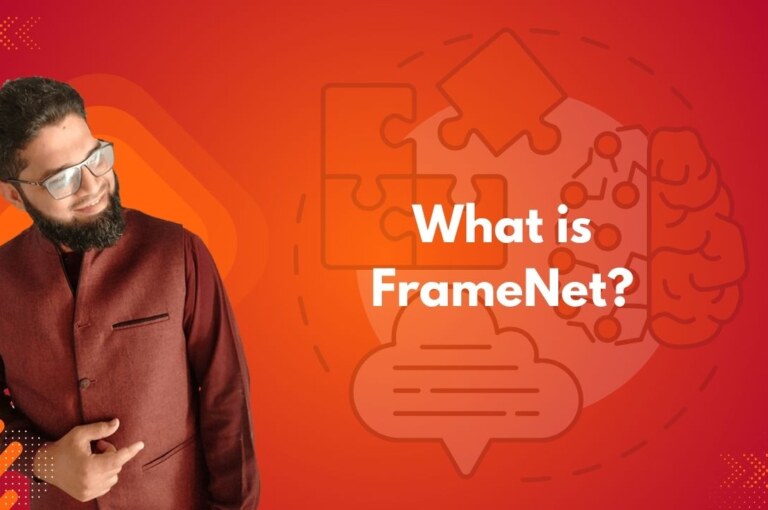FrameNet is a lexical database built around the idea of semantic frames—conceptual structures that capture the relationships between words, their meanings, and the roles they play in real-world scenarios. It doesn’t just focus on literal definitions but connects words to broader contexts and use cases.
FrameNet bridges the gap between syntax and meaning, enabling systems to comprehend how words function in sentences based on context.
It works in tandem with linguistic theories such as frame semantics, and supports advanced language technologies like natural language understanding and linguistic semantics.
Key Concepts in FrameNet
1. Frames
Frames represent mental models that group related roles and concepts. For instance, the word “buy” activates a Buying frame, which includes participants like Buyer, Seller, Goods, and Transaction.
2. Rolesets
Rolesets define the various meanings a word can take depending on context. For example, “run” can refer to an athlete running, someone managing a company, or a machine in operation—each linked to different frames.
3. Word-Sense Representations
FrameNet assigns multiple senses of a word to appropriate frames, helping disambiguate its meaning in various contexts.
Closing thought: These concepts form the backbone of how FrameNet supports accurate language understanding, crucial for both human interpretation and machine learning.
Common Verbs and Their Associated Frames in FrameNet
The following table provides examples of commonly used English verbs and the corresponding semantic frames they activate, along with the roles (also called “Frame Elements”) typically involved.
This illustrates how FrameNet structures meaning through frame-role associations:
| Verb | Frame Name | Key Roles (Frame Elements) | Example Sentence |
|---|---|---|---|
| Buy | Commerce_buy | Buyer, Seller, Goods, Money, Transaction | She bought a car from the dealership. |
| Give | Giving | Donor, Recipient, Theme | He gave his sister a gift. |
| Run | Operating_a_system | Operator, System, Duration | She runs a local software company. |
| Break | Cause_damage | Agent, Object | The child broke the vase accidentally. |
| Travel | Travel | Traveler, Origin, Destination, Path, Vehicle | They traveled from Paris to Rome by train. |
| Teach | Teaching | Teacher, Student, Subject, Means | She teaches chemistry to high schoolers. |
This table provides a concrete example of how FrameNet’s structure supports both human understanding and machine learning by mapping verbs to their frames and contextual roles. It’s especially helpful for training AI systems to disambiguate meaning, label semantic roles, and process natural language accurately.
The Purpose of FrameNet
FrameNet’s goal is to model the meaning of words in a way that mirrors real-world understanding. By organizing related roles and concepts under frames, it allows both linguists and machines to interpret language contextually and more effectively.
Takeaway: FrameNet transforms abstract language into structured data, making semantic comprehension accessible and useful in computational tasks.
Applications of FrameNet in NLP
FrameNet has numerous uses across natural language processing, it identifies the who, what, and why of actions in a sentence.
For example, “John bought a laptop” would label John as Buyer and laptop as Goods. It helps determine which meaning of a word fits best based on context—vital in resolving words with multiple senses.
By mapping words to frames, FrameNet allows for more accurate text interpretation, aiding in tasks like machine translation and summarization. Its annotated datasets improve the performance of models by teaching them how words interact based on their roles and contexts.
These applications power everything from chatbots to language models, driving deeper comprehension and better performance.
Real-World Example: The Word “Buy”
Let’s take the word “buy”. In FrameNet, it triggers the Buying frame with roles like:
- Buyer – the person purchasing
- Seller – the person offering goods
- Goods – the item being bought
- Transaction – the act of buying
In the sentence “She bought a new car,” FrameNet identifies “She” as the Buyer, “car” as the Goods, and the action as a Transaction.
Recognizing frames like this allows systems to fully understand how the word functions in specific scenarios.
Why FrameNet Matters!
FrameNet offers a rich, structured way to interpret language that aligns with how people think and communicate. It captures the deeper meanings and connections between words, making it indispensable for modern NLP and AI research.
Wrap Up
In summary, FrameNet empowers machines and researchers alike to understand language at a conceptual level. By linking words to semantic frames, it enables better text understanding, disambiguation, and language modeling. As NLP continues to evolve, FrameNet remains a foundational pillar in building more human-like language systems.
Want to Go Deeper into SEO?
Explore more from my SEO knowledge base:
▪️ SEO & Content Marketing Hub — Learn how content builds authority and visibility
▪️ Search Engine Semantics Hub — A resource on entities, meaning, and search intent
▪️ Join My SEO Academy — Step-by-step guidance for beginners to advanced learners
Whether you’re learning, growing, or scaling, you’ll find everything you need to build real SEO skills.
Feeling stuck with your SEO strategy?
If you’re unclear on next steps, I’m offering a free one-on-one audit session to help and let’s get you moving forward.





Leave a comment